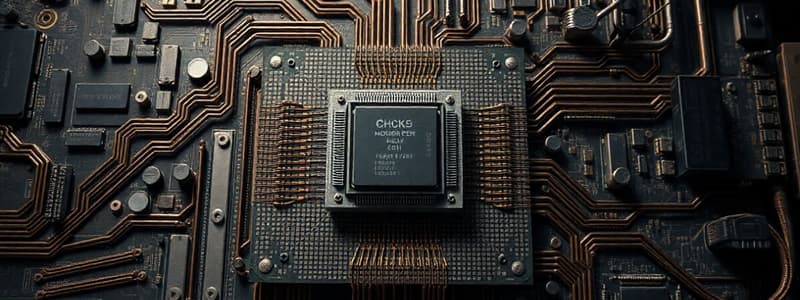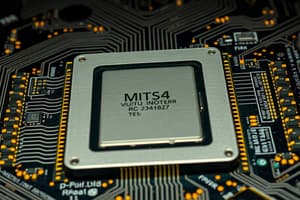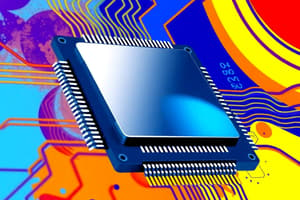Podcast
Questions and Answers
What is the role of the CPU in a computer?
What is the role of the CPU in a computer?
- Interconnecting all components via the motherboard.
- Storing programs for execution.
- Handling input and output operations.
- Performing arithmetic and logical operations. (correct)
Which component is responsible for storing programs to be executed by the computer?
Which component is responsible for storing programs to be executed by the computer?
- Motherboard
- Central Processing Unit (CPU)
- Peripherals
- Central Memory (correct)
How are the three main components of a computer interconnected?
How are the three main components of a computer interconnected?
- Through communication lines on the motherboard. (correct)
- Through encrypted data connections.
- Using external hard drives.
- Via a communications network.
What is a key characteristic of the Von Neumann architectural model?
What is a key characteristic of the Von Neumann architectural model?
What is the purpose of peripherals in a computer system?
What is the purpose of peripherals in a computer system?
Which operation does not belong to the basic functions performed by the CPU?
Which operation does not belong to the basic functions performed by the CPU?
What does the central memory do with regards to the CPU and its operations?
What does the central memory do with regards to the CPU and its operations?
Which statement is true regarding the execution of programs in a computer?
Which statement is true regarding the execution of programs in a computer?
What component is primarily responsible for executing machine instructions?
What component is primarily responsible for executing machine instructions?
Which of the following describes a feature of processors?
Which of the following describes a feature of processors?
What does IPC stand for in relation to CPU performance?
What does IPC stand for in relation to CPU performance?
Which of the following components connects to the motherboard through the CPU socket?
Which of the following components connects to the motherboard through the CPU socket?
What is the purpose of the Arithmetic Logical Unit (ALU) within a CPU?
What is the purpose of the Arithmetic Logical Unit (ALU) within a CPU?
The term 'word size' in processors refers to what?
The term 'word size' in processors refers to what?
Why is a fan required for the CPU?
Why is a fan required for the CPU?
How does the Von Neumann model relate to computer architecture?
How does the Von Neumann model relate to computer architecture?
What is the purpose of the Control Unit (CU) in a CPU?
What is the purpose of the Control Unit (CU) in a CPU?
Which of the following registers are considered special-purpose registers?
Which of the following registers are considered special-purpose registers?
What distinguishes multicore CPUs from single-core CPUs?
What distinguishes multicore CPUs from single-core CPUs?
Which command is used in GNU/Linux to display CPU features?
Which command is used in GNU/Linux to display CPU features?
How are cache memory levels in CPUs typically organized?
How are cache memory levels in CPUs typically organized?
What is the primary function of the Processor Instruction Set?
What is the primary function of the Processor Instruction Set?
Which of the following best describes RISC architecture?
Which of the following best describes RISC architecture?
Which of the following is NOT a type of communication bus in CPUs?
Which of the following is NOT a type of communication bus in CPUs?
What does RISC stand for in computer architecture?
What does RISC stand for in computer architecture?
Which of the following is a characteristic of CISC processors?
Which of the following is a characteristic of CISC processors?
Which processor architecture is commonly used today for most personal computers?
Which processor architecture is commonly used today for most personal computers?
What is one advantage of RISC architecture over CISC?
What is one advantage of RISC architecture over CISC?
Which instruction set architecture is associated with supercomputers like Fugaku?
Which instruction set architecture is associated with supercomputers like Fugaku?
What distinguishes ARM architecture in modern computing from historical architectures?
What distinguishes ARM architecture in modern computing from historical architectures?
What is a primary disadvantage of CISC processors?
What is a primary disadvantage of CISC processors?
Which of the following families is NOT an example of RISC architecture?
Which of the following families is NOT an example of RISC architecture?
What is the final value of the register Ax after executing the provided x86-assembly program?
What is the final value of the register Ax after executing the provided x86-assembly program?
Which operation does the instruction 'JBE T' perform in the assembly program?
Which operation does the instruction 'JBE T' perform in the assembly program?
What does the instruction 'INC Cx' achieve?
What does the instruction 'INC Cx' achieve?
What characteristic is typical of RISC processors?
What characteristic is typical of RISC processors?
What is the primary distinction between single-processor and multi-processor systems?
What is the primary distinction between single-processor and multi-processor systems?
What does the term 'Instruction Per Clock Cycle' refer to?
What does the term 'Instruction Per Clock Cycle' refer to?
How do modern superscalar CPUs enhance performance?
How do modern superscalar CPUs enhance performance?
What may cause certain complex instructions to take multiple clock cycles?
What may cause certain complex instructions to take multiple clock cycles?
What is a defining feature of a TPU?
What is a defining feature of a TPU?
What is one of the benefits of multiprocessor systems?
What is one of the benefits of multiprocessor systems?
Which of the following describes multicore CPUs?
Which of the following describes multicore CPUs?
What characterizes clustered systems?
What characterizes clustered systems?
Which of the following is NOT a characteristic of multiprocessor systems?
Which of the following is NOT a characteristic of multiprocessor systems?
What is one advantage of clustered systems?
What is one advantage of clustered systems?
What is the main function of a general-purpose processor in a TPU?
What is the main function of a general-purpose processor in a TPU?
Why might multicore processors be advantageous in modern computing?
Why might multicore processors be advantageous in modern computing?
Flashcards
CPU
CPU
The central processing unit (also called the processor or microprocessor), responsible for performing arithmetic and logical operations.
Central Memory
Central Memory
The component that stores programs to be executed by the computer, as well as input and output data.
Peripherals
Peripherals
Input/output (I/O) devices used to input or output information to and from the computer.
Motherboard
Motherboard
Signup and view all the flashcards
Von Neumann Architecture
Von Neumann Architecture
Signup and view all the flashcards
Arithmetic and logical operations
Arithmetic and logical operations
Signup and view all the flashcards
System Bus
System Bus
Signup and view all the flashcards
Input Peripherals
Input Peripherals
Signup and view all the flashcards
Output Peripherals
Output Peripherals
Signup and view all the flashcards
Motherboard
Motherboard
Signup and view all the flashcards
System Bus
System Bus
Signup and view all the flashcards
Von Neumann Architecture
Von Neumann Architecture
Signup and view all the flashcards
CPU (Central Processing Unit)
CPU (Central Processing Unit)
Signup and view all the flashcards
Processor Frequency
Processor Frequency
Signup and view all the flashcards
Processor Internal Memory
Processor Internal Memory
Signup and view all the flashcards
Processor Word Size
Processor Word Size
Signup and view all the flashcards
Processor Cores
Processor Cores
Signup and view all the flashcards
Arithmetic Logic Unit (ALU)
Arithmetic Logic Unit (ALU)
Signup and view all the flashcards
Instruction Per Clock Cycle (IPC)
Instruction Per Clock Cycle (IPC)
Signup and view all the flashcards
CISC
CISC
Signup and view all the flashcards
RISC
RISC
Signup and view all the flashcards
Processor Instruction Set
Processor Instruction Set
Signup and view all the flashcards
x86 processors
x86 processors
Signup and view all the flashcards
ARM processors
ARM processors
Signup and view all the flashcards
Control Unit (CU)
Control Unit (CU)
Signup and view all the flashcards
Registers
Registers
Signup and view all the flashcards
General-Purpose Registers
General-Purpose Registers
Signup and view all the flashcards
Special-Purpose Registers
Special-Purpose Registers
Signup and view all the flashcards
Cache Memory
Cache Memory
Signup and view all the flashcards
Communication Buses
Communication Buses
Signup and view all the flashcards
Multicore CPU
Multicore CPU
Signup and view all the flashcards
Processor Instruction Set
Processor Instruction Set
Signup and view all the flashcards
CISC
CISC
Signup and view all the flashcards
RISC
RISC
Signup and view all the flashcards
TPUs
TPUs
Signup and view all the flashcards
Multiprocessor Systems
Multiprocessor Systems
Signup and view all the flashcards
Multicore CPUs
Multicore CPUs
Signup and view all the flashcards
Clustered Systems
Clustered Systems
Signup and view all the flashcards
Processor Instruction Set
Processor Instruction Set
Signup and view all the flashcards
x86-assembly
x86-assembly
Signup and view all the flashcards
Instruction Per Clock Cycle (IPC)
Instruction Per Clock Cycle (IPC)
Signup and view all the flashcards
Sequential CPU
Sequential CPU
Signup and view all the flashcards
Pipelined CPU
Pipelined CPU
Signup and view all the flashcards
RISC Processor
RISC Processor
Signup and view all the flashcards
Superscalar CPU
Superscalar CPU
Signup and view all the flashcards
Single-Processor System
Single-Processor System
Signup and view all the flashcards
Study Notes
Information Technology Essentials - Lecture 4
- Computer Architecture: Computers have evolved in structure, size, and performance. However, generally computers have three main components.
- CPU (Central Processing Unit): Also known as a Processor or Microprocessor. It performs arithmetic and logical operations.
- Central Memory: Stores programs to be executed by the computer.
- Peripherals (I/O Devices): Input/output devices used to exchange information to and from the computer.
- Motherboard: Interconnects the CPU, central memory, and peripherals via communication lines (system bus).
Von Neumann Architectural Model
- Represents a computer with a Central Processing Unit, Central Memory Unit, and Input/Output Units.
- Components are connected via System Bus (Control Bus, Address Bus, Data Bus).
- This model illustrates how components interact for basic functionality.
CPU (Recap)
- CPU operations: Executing programs involve performing arithmetic and logical operations.
- CPU Memory: The central memory temporarily stores programs for execution, as well as input and output.
- Input/Output peripherals: Input peripherals receive user input; output peripherals display results to the user.
- Communication: The motherboard connects components through the system bus for communication.
- Modern computers: The Von Neumann architectural model represents general-purpose computers.
Central Processing Unit (CPU)
- Processors (Microprocessors): Complex electronic circuits for fast machine instruction execution.
- Processor Features: Frequency (MHz/GHz), internal memory (cache/registers), word size (8-64 bit), and number of cores.
- CPU Socket: Connects processor to motherboard.
- Cooling: CPUs require cooling (fan) to regulate temperature.
CPU (Structural Components)
- Arithmetic Logic Unit (ALU): Performs arithmetic and logical operations.
- Control Unit (CU): Fetches and decodes instructions.
- Registers: Small, high-speed storage locations, general and special use purpose (like MAR, MBR, PC etc.).
- Cache Memory: Small, fast memory organized in levels (L1, L2, L3).
- Communication Buses: Address, data, and control buses for communication.
Modern CPU Design
- Multicore: Modern CPUs have multiple computing cores on a single chip, for example, Intel Pentium D, Core i3/i5/i9, AMD Ryzen 3 etc.
- Multicore Operation: Each core has its own ALU and CU in most cases, and shared cache.
- CPU Feature Query (Windows): Windows PCs display CPU information in System > About.
Modern CPU Design (GNU/Linux)
- Command: The GNU/Linux
lscpucommand displays CPU details (architecture, cores, threads, cache size, etc.).
Processor Instruction Set
-
Set of Machine Instructions: Defines instructions a processor can decode and execute.
-
CISC and RISC: Two major instruction set architectures.
-
CISC (Complex Instruction Set Computers): Single instructions to handle multiple low-level operations (e.g., PDP-11).
- Fewer instructions are required for complex operations.
- Easier to implement with microprogramming.
- Typically uses more transistors as instructions have more complex operations.
-
RISC (Reduced Instruction Set Computers): One instruction per low-level operation.
- More instructions are needed for complex operations.
- More efficient because the instructions are simpler.
- Generally less expensive as the chip designs are simpler and use fewer transistors.
-
x86 architecture: Common in personal computers.
-
ARM architecture: Common in mobile devices, embedded systems.
-
Specific Example: (x86) MOV, INC, CMP, JE, HLT
-
Machine Instructions and Opcodes: The transformation of assembly instructions into machine instructions (OPcodes) handled by assembler programs (like NASM).
-
Instruction Byte Sizes: Instruction sets have multiple byte sizes for different instructions (Intel, 1-14 bytes).
-
Clock Cycle and Execution: Different instructions may use different clock cycle times for execution.
-
Instruction per Clock Cycle: Earlier processors executed only one simple instruction per clock cycle; newer processors (pipelined/superscalar) execute multiple instructions per clock cycle (Instruction-Level Parallelism (ILP)).
Single Processor Systems
- Single CPU: Only one CPU capable of general-purpose tasks.
- Special Processors: Systems may include other special-purpose processors for tasks like device control or on mainframes.
- Example: A computer with only one general-purpose processor, and multiple other special-purpose processors is still considered a single-processor system.
- Graphical Processing Unit (GPU): Specialized for visual and graphical tasks, often used for scientific simulations or cryptanalysis.
- Tensor Processing Unit (TPU): Specialized for high-speed, low-latency machine learning tasks using deep learning algorithms.
Multiprocessor Systems
- Multiple CPUs: Two or more CPUs executing a general-purpose instruction set, share memory and peripherals, etc.
- Applications: Multiprocessor systems, such as those seen in servers, eventually became available on desktops, laptops and smartphones.
- Improvements: Provide higher throughput, response time, turn-around time, greater reliability, compared to single-core systems.
Clustered Systems
- Connected Multiprocessing: Several interconnected computer systems (hosts).
- Functionalities: Hosts are connected via local area networks; share storage and resources; provide high availability.
- Specific applications: Used in high-performance computing (HPC) environments.
Studying That Suits You
Use AI to generate personalized quizzes and flashcards to suit your learning preferences.




